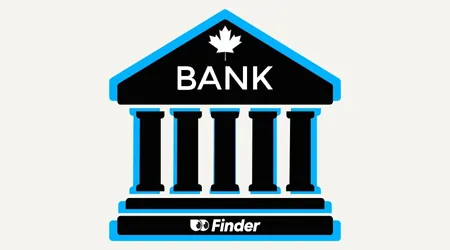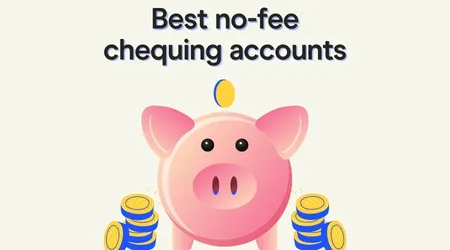International bank accounts offer valuable solutions for managing cross-border finances, whether you’re traveling frequently, studying abroad or handling international transactions. With benefits like free or low-cost transfers, access to global ATMs and multi-currency support, these accounts are tailored to a variety of needs.
This guide highlights some of the top international banking options in Canada, comparing fees, features and benefits to help you choose the account that fits your needs.
International bank accounts you can open online
| Account | Monthly fee | International money transfer fee | |
|---|---|---|---|
Simplii No Fee Chequing Account | $0 | $0 | |
EQ Bank Personal Account | $0 | Small conversion fee depending on the currency (not available in Quebec) | |
BMO Performance Chequing Account | $17.95 | $0 | |
BMO Premium Plan Chequing Account | $30.95 | $0 | |
Scotiabank Preferred Package | $16.95 | $1.99 | |
Scotiabank Ultimate Package | $30.95 | $0 | |
RBC Signature No Limit Banking Account | $16.95 | $0 | |
RBC VIP Banking Account | $30 | $0 |
International banks in Canada
Several Canadian banks have established international branches to serve clients worldwide. Notable among these are:
- Scotiabank (Bank of Nova Scotia): Known as “Canada’s most international bank,” Scotiabank has over 3,000 branches, operating in over 20 countries across regions including the Caribbean, Central and South America, Europe and Asia.
- RBC (Royal Bank of Canada): RBC has a significant international presence, particularly in the United States and the Caribbean.
- TD (Toronto-Dominion Bank): TD Canada Trust has significantly expanded into the United States, operating over 1,100 branches along the East Coast.
- BMO (Bank of Montreal): BMO maintains a notable presence in the United States, offering personal and commercial banking services.
- CIBC (Canadian Imperial Bank of Commerce): CIBC has expanded its footprint into the US market, offering personal and business banking services through CIBC Bank USA. This expansion allows CIBC to serve clients with cross-border banking needs.
International student bank accounts in Canada
International student bank accounts in Canada are designed to meet the unique needs of students studying abroad. These accounts often offer benefits like no monthly fees, access to international transfers and perks like rewards or cash bonuses.
Below, we outline some of the best student banking options, highlighting features and how each one caters to international students.
| Account | Monthly fee | International banking features | |
|---|---|---|---|
BMO Performance Student Chequing Account | $0 | No-fee Global Money Transfers | |
Simplii Financial Student No Fee Chequing Account | $0 | Guaranteed Investment Certificate access | |
Scotiabank Preferred Package for Students and Youth | $0 | Rewards when you bundle banking products | |
RBC Advantage Banking for Students | $0 for full time students | No fees for US and International transfers | |
CIBC Smart for Students | $0 if you graduate before turning 25 | $5 per transaction, plus 2.5% administration fee | |
TD Student Chequing Account | $0 | Earn $125 for opening a Student Chequing account, and get Global Transfer fees rebated for up to 12 months |
What is the best international bank?
The best international bank for you depends on your banking needs. For example, if you’re a Canadian who is planning on doing a lot of banking in the US, a bank like TD or BMO might be best. If you plan to do banking in Asia or Europe, Scotiabank may be the best international bank for you.
International banks with branches in Canada
Some international banks have also expanded into the Canadian market. One of the biggest examples of that is ICICI Bank, which is headquartered in Mumbai, India but expanded into Canada in 2003.
Alternatively, there are some banks that have tried to expand into Canada, but had to withdraw. The UK-based bank, Revolut, is a good example of that. It first expanded into Canada in 2019 but left the Canadian market in 2021.
How to choose the best international bank account
The best international bank accounts offer features that simplify banking, such as low fees, free transfers and access to global services. When comparing accounts, consider your specific needs like frequent travel or international transactions. Below are key features to look for along with examples of accounts that excel in each area.
Free international money transfers
If you frequently send money abroad, international bank accounts that waive transfer fees can save you hundreds of dollars. The Simplii No Fee Chequing Account, for example, allows you to send free international transfers to over 130 countries worldwide.
International customer service
Round-the-clock support is crucial when banking across time zones. Accounts like the RBC VIP Banking Account offer dedicated international customer service to handle your needs wherever you are. This ensures your issues are resolved quickly, no matter the time or place.
International ATM access
Frequent travelers should prioritize accounts that offer fee-free or discounted international ATM withdrawals. For example, as a founding member of the Global ATM Alliance, Scotiabank provides fee-free access to over 44,000 ATMs in more than 40 countries. This benefit helps you save money and avoid unnecessary fees when withdrawing cash abroad.
International branch access
Having access to physical branches in multiple countries is invaluable for resolving issues in person when the occasion arises. For example, Scotiabank operates over 2,000 branches and offices across 50 countries, including the Caribbean, Central and South America and parts of Asia. This extensive network ensures that, as a Scotiabank customer, you have access to in-person banking services and support while travelling or living abroad.
Low currency conversion fees
Currency conversion fees can quickly add up when traveling or making international transactions, cutting into your savings. Some accounts like the EQ Bank Personal Account offer low, transparent fees to help you avoid unexpected costs. Similarly, the Simplii No Fee Chequing Account is a great international bank account choice if you want to send funds to your home country with no transfer fees.
Access to US funds
Canadians traveling or doing business in the US benefit from accounts offering easy access to US dollars. The RBC Signature No Limit Banking Account simplifies cross-border banking with access to US funds. Having this feature on your international bank account avoids costly conversion fees and ensures smooth transactions.
International bank account fees
International bank accounts often come with various fees. One common charge is the currency exchange fee, applied when converting funds between currencies. These fees typically range from 1% to 3% of the transaction amount, depending on the bank and currency.
For example, EQ Bank charges a small, transparent conversion fee, while other banks may include markups within their exchange rates.
Another frequent charge is the international money transfer fee, which varies widely from $0 to $45 or more based on the bank and destination. Additionally, foreign transaction fees—usually 2.5% to 3% of the transaction—apply when using your debit card for purchases or withdrawals in a foreign currency.
Not to be mistaken for conversion fees, foreign transaction fees specifically cover the cost of processing credit and debit card transactions outside Canada or in non-CAD currencies. Note, this means you can often expect to pay both the foreign transaction fee and the conversion fee when making international purchases.
To reduce costs, consider options like the EQ Bank Personal Account, which has low currency conversion fees, or the RBC Signature No Limit Banking Account, which waives international transfer fees. These accounts can be particularly beneficial for frequent travelers or those managing funds across currencies.
Tips to avoid foreign transaction fees
Here are a few ways to stop paying a foreign transaction fee when you swipe your credit card:
- Exchange currency before you leave Canada. Converting money at your home bank before you head off overseas could save you the conversion fee.
- Consider cross-border banking. Some banks partner with other institutions to bring customers fee-free access overseas. For example, Scotiabank is a founding member of the Global ATM Alliance. When you’re travelling outside Canada, you can use the ABMs of international banks in the Alliance; you’ll skip the surcharge and save on access fees.
- Get cash back at checkout. If you use your debit card in a store in another country, you may be able to get cash back at the checkout without paying any fees.
- Get a card with no FX fees. Consider getting a prepaid, credit card or debit card that doesn’t charge foreign transaction fees. Good options include a Wise Virtual Debit Card or the EQ Bank Card.
- Consider a foreign currency account. If you regularly spend or get paid in other currencies, a foreign currency account allows you to hold funds in the international currency of your choice.
How to open an international bank account online
Opening an international bank account online is straightforward and is often similar to the process of opening a domestic account. Here’s a simple step-by-step guide to help you get started:
- Select the Go to site button for an international bank account in the table above to visit the financial institution’s website.
- Fill in your necessary personal details, including your name, address, date of birth and citizenship.
- Verify your identity by uploading a government-issued photo ID, such as a passport or driver’s license.
- If required, provide proof of address (e.g. a utility bill) or proof of income (e.g. a recent pay stub).
- Fund your account by making the minimum initial deposit, if applicable.
- Confirm your application and wait for approval, which can take anywhere from a few minutes to several days.
- Once approved, set up online banking access and order any necessary physical bank cards.
Can I open an international bank account online for free?
Yes, several banks allow you to open international accounts for free with no monthly fees. Examples include the Simplii No Fee Chequing account or the EQ Bank Personal account, both of which can be opened online in just a few steps. These accounts are ideal for Canadians seeking budget-friendly international banking.
What is an international bank account number?
An International Bank Account Number, or IBAN, is a standardized numbering system that helps facilitate international money transfers, especially within Europe and other specific regions.
Unlike Canadian bank accounts, which rely primarily on a combination of transit numbers and institution codes for domestic transactions, an IBAN provides a unique, globally recognized identifier for bank accounts across borders.
Although Canadian banks don’t issue IBANs, understanding these numbers is essential for Canadians sending money abroad to IBAN-supported countries.
An IBAN includes a combination of letters and numbers typically beginning with a two-letter country code followed by cheque digits and a series of alphanumeric characters that uniquely identify the recipient’s bank and account.
This system is used to ensure international transfers are accurate and efficient. For Canadians, using an IBAN is straightforward if your bank or financial service supports international wire transfers. You may need the recipient’s IBAN and SWIFT/BIC code to ensure funds are routed correctly.
How to transfer money to an international bank account
- Choose a transfer method. Decide whether to use your bank, a money transfer service like Wise or Western Union or an online platform like PayPal that specializes in sending money internationally.
- Log in or register. Access your online banking account or sign up for a transfer service.
- Enter the recipient’s information. Provide the recipient’s name, bank name, account number and SWIFT/BIC or IBAN.
- Select the currency and amount. Specify the currency and amount you wish to send.
- Pay for the transfer. Use your bank account, debit card or credit card to fund the transfer.
- Track the transfer. Monitor the progress of your transaction and confirm that the recipient has received the funds.
What is the Canadian bank account number format for international transfers?
When managing international transfers to Canadian bank accounts, it’s essential to provide accurate account details to ensure smooth transactions. Canadian bank account numbers are typically structured as follows:
- Institution number: A 3-digit code identifying the financial institution. For example, Royal Bank of Canada’s institution number is 003.
- Transit number: A 5-digit code identifying the specific branch where the account is held. This number is unique to each branch.
- Account number: Typically a 7- to 12-digit number unique to the account holder. If your account number has fewer digits, you may need to add leading zeros to meet the required length.
These three components work together like a street address (bank) and house number (specific account) to make sure money arrives in the right place.
Sometimes, the sender also needs a SWIFT code. This is like the international nickname for the bank, so the foreign bank knows which Canadian bank to contact.
Example of a Canadian bank account number format
Imagine you’re sending money to someone who banks at RBC. The details might look like this:
- Transit number: 12345
- Institution number: 003
- Bank account number: 1234567
- SWIFT code: ROYCCAT2
The bank account number is separate from the transit and institution numbers but is equally important. Together, these details guide money to the right account.
Bottom line
Choosing the right international bank account depends on your financial needs, such as minimizing fees, managing currency exchanges or accessing funds abroad. Canadian banks offer a variety of options tailored to different purposes, from free accounts with essential features to premium packages with extensive global benefits.
By comparing key features like international money transfer fees, ATM access and customer service, you can select the account that best suits your lifestyle. Whether you’re a frequent traveler, a student or someone managing cross-border finances, the accounts outlined in this article provide excellent starting points for seamless international banking.
FAQs about international bank accounts
More banking guides from our experts

Banking statistics and trends in Canada for 2025
Explore key banking statistics and figures from the Finder: Consumer Sentiment Survey January 2025.
Read more…
Best free (no-fee) chequing accounts in Canada
Compare the features of 8 of the best no-fee chequing accounts in Canada, and find out how to avoid transaction fees.
Read more…
16 best new bank account offers for August 2025
Earn cash, rewards points, bonus interest rates and more with these new bank account offers and promotions.
Read more…
Best youth bank accounts in Canada
Learn about the different types of bank accounts for your teenager and how to choose the right one.
Read more…
Best chequing accounts in Canada for 2025
Compare chequing accounts and learn about our top picks. Compare different features and see which one is right for you.
Read more…
Open a bank account online in Canada in 5 easy steps
Compare and open a bank account online in Canada in as little as 5 minutes. Learn what you need to apply and how to get started today.
Read more…More guides on Finder
-
The best banks in Canada for 2025
We compare Canada’s best banks to help you find your perfect banking match.
-
Scotiabank promotions and offers
Explore all the latest Scotiabank promotions and offers available now.
-
Simplii Financial vs CIBC: Which bank is right for you?
Compare Simplii Financial vs CIBC to find the best digital bank in Canada for you.
-
Simplii Financial vs KOHO: Which one is right for you?
Compare Simplii vs KOHO to see which digital bank best suits your everyday financial needs.
-
Simplii Financial vs EQ Bank: Which bank is right for you?
Simplii and EQ Bank go head to head on fees, features, rates and mobile apps.
-
EQ Bank vs KOHO: Which one is best for you?
Compare EQ Bank vs KOHO to find the best digital bank in Canada for you.
-
6 Alternatives to KOHO
Your guide to the 6 best Koho alternatives in Canada.
-
14 best new bank account offers for August 2025
Earn cash, rewards points, bonus interest rates and more with these new bank account offers and promotions.
-
Bank of Canada interest rate forecast report
Read Finder’s BoC Interest Rate Report for forecasts from some of Canada’s brightest minds in economics and learn more about how recent rate increases could affect Canada’s real estate market.
-
Tangerine vs EQ Bank: Which bank is better?
Compare Tangerine and EQ Bank to find the best digital bank in Canada for you.
